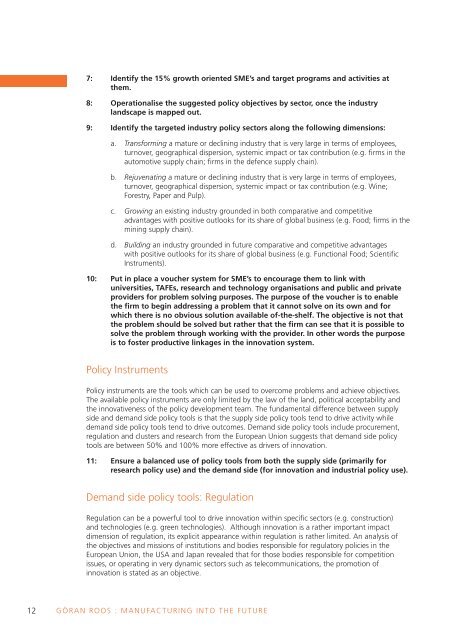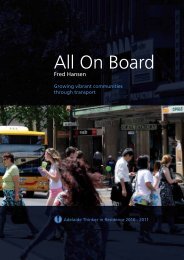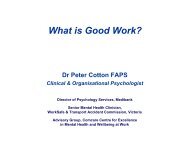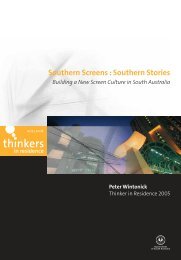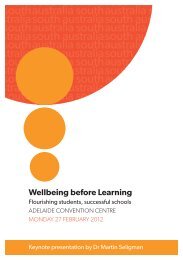Manufacturing into the future - Adelaide Thinkers in Residence - SA ...
Manufacturing into the future - Adelaide Thinkers in Residence - SA ...
Manufacturing into the future - Adelaide Thinkers in Residence - SA ...
- No tags were found...
Create successful ePaper yourself
Turn your PDF publications into a flip-book with our unique Google optimized e-Paper software.
7: Identify <strong>the</strong> 15% growth oriented SME’s and target programs and activities at<strong>the</strong>m.8: Operationalise <strong>the</strong> suggested policy objectives by sector, once <strong>the</strong> <strong>in</strong>dustrylandscape is mapped out.9: Identify <strong>the</strong> targeted <strong>in</strong>dustry policy sectors along <strong>the</strong> follow<strong>in</strong>g dimensions:a. Transform<strong>in</strong>g a mature or decl<strong>in</strong><strong>in</strong>g <strong>in</strong>dustry that is very large <strong>in</strong> terms of employees,turnover, geographical dispersion, systemic impact or tax contribution (e.g. firms <strong>in</strong> <strong>the</strong>automotive supply cha<strong>in</strong>; firms <strong>in</strong> <strong>the</strong> defence supply cha<strong>in</strong>).b. Rejuvenat<strong>in</strong>g a mature or decl<strong>in</strong><strong>in</strong>g <strong>in</strong>dustry that is very large <strong>in</strong> terms of employees,turnover, geographical dispersion, systemic impact or tax contribution (e.g. W<strong>in</strong>e;Forestry, Paper and Pulp).c. Grow<strong>in</strong>g an exist<strong>in</strong>g <strong>in</strong>dustry grounded <strong>in</strong> both comparative and competitiveadvantages with positive outlooks for its share of global bus<strong>in</strong>ess (e.g. Food; firms <strong>in</strong> <strong>the</strong>m<strong>in</strong><strong>in</strong>g supply cha<strong>in</strong>).d. Build<strong>in</strong>g an <strong>in</strong>dustry grounded <strong>in</strong> <strong>future</strong> comparative and competitive advantageswith positive outlooks for its share of global bus<strong>in</strong>ess (e.g. Functional Food; ScientificInstruments).10: Put <strong>in</strong> place a voucher system for SME’s to encourage <strong>the</strong>m to l<strong>in</strong>k withuniversities, TAFEs, research and technology organisations and public and privateproviders for problem solv<strong>in</strong>g purposes. The purpose of <strong>the</strong> voucher is to enable<strong>the</strong> firm to beg<strong>in</strong> address<strong>in</strong>g a problem that it cannot solve on its own and forwhich <strong>the</strong>re is no obvious solution available of-<strong>the</strong>-shelf. The objective is not that<strong>the</strong> problem should be solved but ra<strong>the</strong>r that <strong>the</strong> firm can see that it is possible tosolve <strong>the</strong> problem through work<strong>in</strong>g with <strong>the</strong> provider. In o<strong>the</strong>r words <strong>the</strong> purposeis to foster productive l<strong>in</strong>kages <strong>in</strong> <strong>the</strong> <strong>in</strong>novation system.Policy InstrumentsPolicy <strong>in</strong>struments are <strong>the</strong> tools which can be used to overcome problems and achieve objectives.The available policy <strong>in</strong>struments are only limited by <strong>the</strong> law of <strong>the</strong> land, political acceptability and<strong>the</strong> <strong>in</strong>novativeness of <strong>the</strong> policy development team. The fundamental difference between supplyside and demand side policy tools is that <strong>the</strong> supply side policy tools tend to drive activity whiledemand side policy tools tend to drive outcomes. Demand side policy tools <strong>in</strong>clude procurement,regulation and clusters and research from <strong>the</strong> European Union suggests that demand side policytools are between 50% and 100% more effective as drivers of <strong>in</strong>novation.11: Ensure a balanced use of policy tools from both <strong>the</strong> supply side (primarily forresearch policy use) and <strong>the</strong> demand side (for <strong>in</strong>novation and <strong>in</strong>dustrial policy use).Demand side policy tools: RegulationRegulation can be a powerful tool to drive <strong>in</strong>novation with<strong>in</strong> specific sectors (e.g. construction)and technologies (e.g. green technologies). Although <strong>in</strong>novation is a ra<strong>the</strong>r important impactdimension of regulation, its explicit appearance with<strong>in</strong> regulation is ra<strong>the</strong>r limited. An analysis of<strong>the</strong> objectives and missions of <strong>in</strong>stitutions and bodies responsible for regulatory policies <strong>in</strong> <strong>the</strong>European Union, <strong>the</strong> U<strong>SA</strong> and Japan revealed that for those bodies responsible for competitionissues, or operat<strong>in</strong>g <strong>in</strong> very dynamic sectors such as telecommunications, <strong>the</strong> promotion of<strong>in</strong>novation is stated as an objective.12GÖRAN ROOS : MANUFACTURING INTO THE FUTURE


